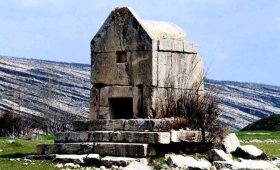The Mysterious Tomb of Gur-e Dokhtar: A Forgotten Legacy of the Achaemenid Era
Near the town of Borazjan in Bushehr Province, a mysterious ancient tomb stands in solitude, surrounded by the vast and remote plains. Known as Gur-e Dokhtar, this historical structure bears a striking resemblance to the tomb of Cyrus the Great in Pasargadae, yet it is more modest in design. The tomb’s simple stone blocks and minimal carvings suggest it belongs to the Achaemenid period, but its exact origins remain uncertain.
A Lost Royal Burial?
Despite the lack of inscriptions or historical records, scholars believe that Gur-e Dokhtar was built for a member of the Achaemenid royal family. Some theories suggest it could be the tomb of Mandana, the mother of Cyrus the Great, or Atossa, the daughter of Cyrus. However, no definitive evidence confirms these claims.
Architectural Similarities with the Tomb of Cyrus
The tomb’s structure closely resembles that of Cyrus the Great’s tomb, featuring:
- A stepped base leading to a small chamber,
- Large stone blocks with simple yet sturdy construction,
- A sloping roof made from carefully arranged stone slabs.
However, unlike the grand and refined tomb in Pasargadae, Gur-e Dokhtar appears rougher, with less precise stonework and a more compact design.
A Hidden Treasure in the Iranian Landscape
Gur-e Dokhtar remains one of Iran’s lesser-known archaeological sites. Its remote location and lack of historical documentation have kept it away from mainstream tourism. Despite this, its resemblance to the Achaemenid royal tombs makes it an important piece of Iran’s cultural heritage.
How to Visit Gur-e Dokhtar
The tomb is located near Borazjan, Bushehr Province, approximately 130 km north of Bushehr city. Visitors must travel through rural roads and open landscapes to reach the site. The best time to visit is during autumn and winter, as Bushehr’s summers can be extremely hot.

